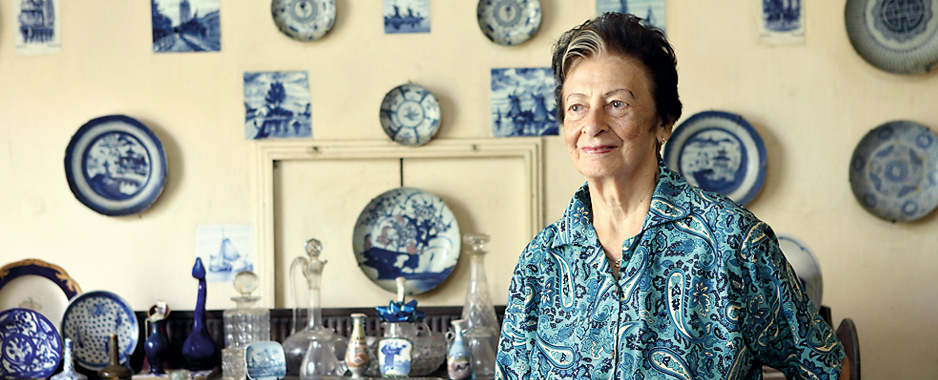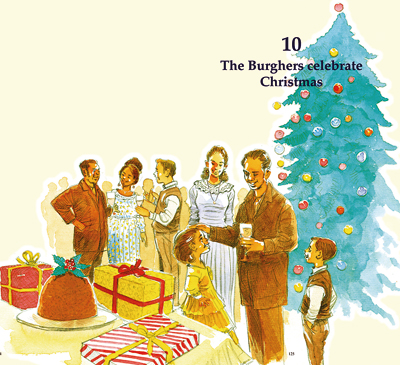Deloraine’s ‘Sugar and Spice’, just in time for Christmas
View(s):When Deloraine Brohier chanced upon a yellowed manuscript in her late father, renowned scholar Dr. R.L. Brohier’s library, she knew it was a valuable find. In the faded pages were “Rare recipes of a Huisvrouw of 1770’. Another discovery was an old manual dated 1875 which had an article on the culinary arts of the island.

The author at home. Pic by Luxshmanan Nadaraja
Considered an authority herself on Burgher life and customs, Deloraine was intrigued. And so began her effort to document the cuisine of the Burgher housewives handed down over generations in the making of those delicacies such as Bolo d’Amor (love cake), Karmenatchi, Fios, Breudher, lamprais and frikkadels, some of which we still enjoy today. Her book ‘A Taste of Sugar and Spice’- Cuisine of the Dutch Burgher Huisvrouw in Olde Ceylon’ draws on the old manuscripts and her own personal recollections of Burgher family customs and celebrations.
“It is my hope that through a book such as this the traditions of a community, a once distinct people and their lifestyle may live on. For they came to this island from lands far away and developed a way of life of their own – in generations before our time. Much of the things they used to do, the way they lived have changed and may fade away in the years to come. But the slow calm and dignity of life, the genial grace of the days that are gone, will be remembered,” she writes.
Published here is an extract from the Chapter ‘The Burghers celebrate Christmas’ from the book which will be launched at the Dutch Burgher Union Hall on Tuesday, December 18 and will thereafter be available at bookshops.
**************************
Christmas was the happiest occasion in the Burgher calendar with most families and was celebrated with tradition. As the months of the year moved on to November and December, when the north east winds began to blow, the nights becoming cooler and the evening shorter, the anticipation of Christmas brought a feeling of excitement and delight for young and old.
Children of Burgher families had both the Dutch Sint Nikolaas as well as Santa Claus-one celebration typically Dutch and the other that came with the British. For the Burghers, on 5th December each year, the Sint Nikolaas fete as in Holland, is celebrated at the Dutch Burgher Union of Ceylon (DBU). The little girls in pretty party dresses and mine generally of organdy designed and sewn by Granny Brohier and young boys in their Sunday best filled the garden and hall. Games and fun kept us busy in the early evening.
As dusk was creeping in, Sint Nikolaas rode in on a tall white horse – not as Santa Claus- but as a stately Bishop. He was dressed in regal finery of a rich brocade, flowing robe of red and gold and a cloak falling from his shoulders, wearing a mitre or high head dress and carrying a long crook or crozier in his hand. He was accompanied by his servant known as Black Pete, his face daubed in charcoal and grease, who carried a thorny birch rod with which to spank the naughty children. Each boy and girl under twelve years of age was handed a gift by Sint Nikolaas.
Then in groups of particular friends, the children would spend the evening running around, playing games of hide and seek, pony riding or whirling around on a small merry-go-round. Most exciting for us young ones was a ride on the improvised roller coaster, which a leading tea firm lent the DBU. In small square boxes the little girls sat two by two and were pushed along to shrieks of merriment.
Meanwhile the adults – mothers and aunts – arranged trestled tables which groaned with food; all the traditional delicacies the Burgher ladies made from authentic recipes dating back to the Portuguese and Dutch periods as handed down the generations. There were huge chunks of love cake (bolo d’amor), the pastry rolls known as foguetti wrapped in crystallized sugar coating and stuffed with pumpkin preserve and minced cashewnut and the Portuguese sweet folo fiado of layered pastry with almonds and raisins. There were plates of thick sandwich rolls filled with asparagus tips, patties in their crisp pastry cases and an assortment of sweets and biscuits in plenty.

There were drinks like iced coffee that the young ones were allowed to indulge in on this occasion and homemade ginger beer in which floated overblown plums. We children ate till our little tummies were full……
The December days that followed brought a plethora of Christmas parties, the singing of Christmas carols from house to house and in homes.
Fir trees which we children used to decorate with tinsel and writing to Santa Claus in anticipation of gifts. Preparations were now afoot in every Burgher home with cooking of Christmas fare, while the fragrant air of roasting and baking pervaded the house from the kitchen……
On Christmas Day, well attired in our Christmas finery, we sat to breakfast before leaving for church. The long dining table had the usual Christmas fare. At one end was a large leg of ham with knuckle and bone and a good hunk of the meat edged with a rim of fat. The ham had been bought days before and cured gradually by being turned alternately to soak in the saltpetre which made it pinky red. It was cooked on Christmas Eve to an old recipe in beer in a slow oven. When it reached the table the following morning it was well dressed, rolled in a fine biscuit powder coating, its outer crust browned and studded with black cloves, like little beady eyes. It was always served with a home-made mustard sauce.
At the other end of the table was a large home-made Flemish dough cake, the breudher. There was salted butter in an earthenware bowl set in water to cool and prevent the butter from melting-set turning oily in the days of no refrigerators. A full ball of Edam cheese with its deep red rind sat as a centrepiece. These were the necessary accompaniments for breudher which in our day was invariably taken with salted butter and Edam cheese.
The making of the breudher took a whole morning of work. It was first kneaded with yeast to make the dough for the cake. For hours tiredly as I remember, Granny and my aunts kept slapping and turning, spooning and twisting the dough and other ingredients by hand till it slipped through the fingers. It was then poured into a special fluted breudher pan and generously sprinkled with plums or raisins before being baked. Granny insisted that the mixture be kept out in the sun before baking for it was believed that it helped the dough to rise and make the cake softer and lighter to taste. I can still picture the scene in Granny’s back verandah, Granny herself helped by one or two of my aunts. This traditional dough cake was always done by hand in days before the modern implements were introduced.
Also figuring prominently was the rich Christmas cake. However, our cake was not a Dutch tradition but was introduced later with the British. The local Christmas cake was very special as made by Burgher huisvrouws and came down the generations from mother to daughter. What the Burghers made was however much richer than the English variety. We children were always around the ceremony and took delight in surreptitiously popping into our mouths a cherry or cashewnut and licking the basins and pans when the mixture was taken to be baked. ….
Also often laid out on the Christmas breakfast table were savouries like pastelos or curry patties piping hot and frikkadels, the little round ball cutlets sizzling straight from the frying pan, besides mouth-watering sweetmeats like poffertjes, fougetti and macaroons which we children delighted in. Wafer-thin slices of freshly baked bread were cut which we ate with slivers of the ham spread with mustard sauce……………
Christmas lunch was with the entire family at Granny Brohier’s. Granny sat at the head table with my parents and older aunts and uncles on either side of her, the children at little tables down the length of the room. From our end there was much more excitement and laughter. Lunch too was a substantial one and could have been stringhoppers with an assortment of curries, sambols and a vegetable soup to douse it all, or it could have been yellow rice with particular accompaniments, on occasion even lamprais, on other occasions, if the family meal and get-together had not been arranged over lunch, a sumptuous evening meal of European menu was served with pork, duckling, turkey and chicken and with many salads, sauces and gravies.
The Christmas dinner was by far the most traditional of the Christmas meals indulged in by the Brohiers as also among other leading Burgher families of those days. The sumptuous Christmas dinner comprised turkey and stuffing, a large leg of cooked ham, its knuckle or bone dressed in a paper decoration and roast duck and pork. The little roasted piglet with red shoeflowers (hibiscus) in its ears and a lime in its mouth was carried in on a large antique China platter indented for the gravy to ooze into a cup which was part of the plate. The meats were carved by Granny or an elder male in the family and sent down the tables. Bowls of baked potatoes in their jackets, hot to the touch, and an assortment of thick brown gravies, salads and vegetables. Pungent mint sauce or jelly to give piquant flavour was a must.
…………………..
For dessert there was a rich Christmas pudding which was ceremoniously brought to the table on a silver salver with a sprig of holly for ornament. The lights were switched off and much merriment would accompany the soaking of the large brown mound of pudding in brandy and then set alight to form a faint blue halo. I can still distinctly remember how fascinating this age old ceremony was. “Dig in!” Granny would exclaim and each and every one of us would help ourselves to substantial heapings of the pudding with dollops of brandy butter.
Then came the nicest and most memorable custom of those days – for when digging into our helpings with spoons, we would search for the little silver trinkets which were dropped when the pudding was in the making in the days before.
There was a horseshoe for luck, a thimble for a maiden aunt, a button for an uncle, a coin signifying fabulous riches in the coming years and a ring which meant love and marriage, which if found in the helping of an eligible girl waiting for a beau would result in much teasing and laughter. …
Taken on the occasion of Christmas were various alcoholic beverages, which the Burghers then, as of now, indulged in. Milk wine was a favourite of the Burgher ladies, the men preferring gin, whisky or brandy. When milk wine was made in my granny’s household, the mixture was left overnight in a very thin pillowcase tied to two chairs so that the liquor filtered through into a basin placed underneath leaving the sediment to collect in the pillowcase. Milk wine had to be of a transparent burgundy colour, slightly sweet of taste and having a faint heady effect due to the arrack it contained. It was served in the best crystal wineglasses.
‘A Taste of Sugar and Spice’ published by Neptune Publications (Pvt) Ltd. is priced at Rs. 3,400.
Follow @timesonlinelk
comments powered by Disqus





















